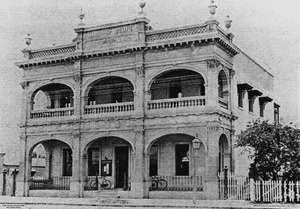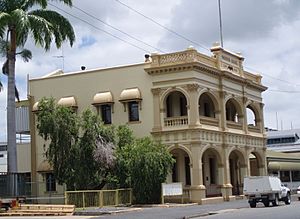Rockhampton Harbour Board Building facts for kids
Quick facts for kids Rockhampton Harbour Board Building |
|
|---|---|

Rockhampton Harbour Board Building, 2009
|
|
| Location | 288 Quay Street, Rockhampton, Rockhampton Region, Queensland, Australia |
| Design period | 1870s - 1890s (late 19th century) |
| Built | 1898 - 1898 |
| Architect | John William Wilson |
| Architectural style(s) | Classicism |
| Official name: Harbour Board (former), Fitzroy Shire Council Chambers | |
| Type | state heritage (built) |
| Designated | 21 October 1992 |
| Reference no. | 600816 |
| Significant period | 1890s (fabric) 1890s-1970s (historical) |
| Significant components | plaque, office/administration building, memorial - plaque |
| Builders | Renshaw & Ricketts |
| Lua error in Module:Location_map at line 420: attempt to index field 'wikibase' (a nil value). | |
The Rockhampton Harbour Board Building is a special old office building located at 288 Quay Street in Rockhampton, Queensland, Australia. It's listed as a heritage site, meaning it's important to history.
This building was designed by an architect named John William Wilson. It was built in 1898 by a company called Renshaw & Ricketts. For a long time, it was known as the Fitzroy Shire Council Chambers. The building was added to the Queensland Heritage Register on October 21, 1992, because of its historical importance.
Contents
A Look Back: The Building's History
The Rockhampton Harbour Board Building was built in 1898. It was made for the new Rockhampton Harbour Board. This board was in charge of the Port of Rockhampton from 1896 until 1979. They worked in this building from 1898 to 1977.
Building such a grand office on Quay Street showed how important the port of Rockhampton was. It also showed how much money the city made from trade in the late 1800s.
Rockhampton's Busy Port
Rockhampton became a "Port of Entry" on October 8, 1858. This happened because many gold seekers came to Canoona. The port served a huge area of Central Queensland. Roads helped bring goods like gold, copper, animal hides, and wool from the inland areas in the 1860s.
In 1867, the Central Western railway line was built west from Rockhampton. This made even more goods flow through the port. The port helped make Rockhampton the main trading and communication hub of the region. Its operations became very important to Rockhampton's economy.
Setting Up the Harbour Board
The Rockhampton Harbour Board was created in 1895 by a special law called the Rockhampton Harbour Board Act. It took over control of the Port of Rockhampton in January 1896.
The Queensland Government passed the Harbour Board Act of 1892. They wanted to let local areas manage their own ports. This was also a way to save money during a tough economic time. The Act allowed Harbour Boards to be set up in ports that had enough shipping trade to support themselves.
Rockhampton was one of the first three Harbour Boards created in 1895. The others were in Townsville and Bundaberg. Over the next 20 years, more boards were set up in places like Mackay (1896), Cairns (1905), and Gladstone (1913).
These boards took over jobs that used to be done by other government departments. They were given control over port lands to build wharves and other port facilities. They could also charge fees on goods shipped through the harbour. This money helped them pay for building wharves, dredging (making the water deeper), and other port needs.
The Architect and the Building
The Rockhampton Harbour Board building was finished in 1898. It was part of a fancy building boom along Quay Street from the 1860s to the early 1900s. This large, two-story stone building showed how wealthy the Rockhampton Harbour Board was. It proved how important the port had become.
John W. Wilson, the architect, asked for bids to build the structure in March 1897. Wilson was a very important architect in Rockhampton from 1864 to the 1890s. He designed many buildings that gave Rockhampton its consistent look. Six of the Quay Street buildings built before 1901 were designed by him. Wilson designed over 200 buildings in the central Queensland area during his 35-year career. The Harbour Board building is one of his most impressive designs.
The building's foundations were made "particularly strong." They were left to settle for a month before construction continued. This was done because other Rockhampton buildings had problems with their foundations moving and causing cracks. The former Harbour Board building is one of the few buildings from its time in Rockhampton that doesn't have major cracks from foundation movement.
Later Uses
The Fitzroy Shire Council bought the building in 1977. They used it as their offices until 1995. A private owner bought the building in February 1995.
What the Building Looks Like
The former Harbour Board building is a two-story stone building with a smooth, rendered (plastered) finish. It faces Quay Street and overlooks the Fitzroy River. The front of the building has an impressive design with arches and columns.
On the ground floor, there's an arched walkway called a colonnade. Above it, on the first floor, is a balcony with similar arches. Both levels have three arches. These arches are separated by flat columns called pilasters. The ground floor columns are in the Roman Doric style, and the first floor columns are in the Corinthian style.
The ground floor walkway has a tiled floor. You enter the building through a double timber door. There are also tall windows that open onto this walkway. An old marble plaque remembering First World War is on the wall here. There are also two metal plaques. These plaques tell about the building's use by the Rockhampton Harbour Board and the Fitzroy Shire Council.
The back of the building has changed quite a bit. A new, single-story section was added, replacing the original back verandah.
Inside, the building has strong brick walls that were plastered. On the ground floor, you can still see the areas for public and private offices. They have original cedar wood decorations and doors. The main room on the ground floor has a large carved timber reception desk. The name "FITZROY SHIRE COUNCIL" is even set into the floor tiles at the entrance.
The first floor has similar finishes to the ground floor. Many of the original cedar doors are still there. Two rooms and a hallway face the Quay Street balcony. They all have access through French doors.
Why This Building is Important
The former Rockhampton Harbour Board Building is listed on the Queensland Heritage Register. This means it's recognized as a very important historical site.
A Piece of Queensland's Story
This building, built in 1898, shows how important the Port of Rockhampton was. The port helped make Rockhampton a major business center in Queensland in the late 1800s. The building also represents a Queensland government idea to create Harbour Boards. These boards helped manage and maintain ports across the colony around the turn of the century.
Beautiful Design
The former Harbour Board building is a local landmark. It adds a lot to the look of Quay Street and the city of Rockhampton. Its design and how it was built show great skill. The details and finishes of the materials are of very high quality.
Special to Rockhampton
This building is special to the people of Rockhampton. It's a historical landmark on Quay Street and is closely linked to the city's image.
Connected to a Famous Architect
The building is also important because of its connection to John W. Wilson. It's considered one of his most important works. Wilson was a very busy architect in Rockhampton from 1864 to 1899. He designed about 200 buildings in the Rockhampton area.



